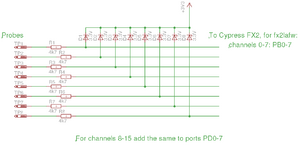Circuits for barebone boards
This page describes which input protection / measuring circuits for barebone or other more minimal boards can be used.
Probing a circuit
Usually for a logic analyzer high input impedance (and low capacitance) is wanted, to influence the measured circuit as least as possible (don't put an additional capacitive load on it). On the other hand, one might want to use an R-C low-pass filter for the signal to block possible higher frequency spikes. If that is wanted or required, it is best to introduce an additional buffering IC that will then drive the load of the introduced capacity of the filter. This can not directly be advised for logic analyzers, but rather for analog instruments (oscilloscopes) that will usually be used in a bigger variety of cases with possibly more noise in the signal.
Input protection
Clamp circuits with resistor / Z-Diodes
A clamp circuit can be used, view below at Spiralbrain's Blog.
Shown here again with numbering for fx2lafw pins:
For boards based on the Cypress CY7C68013A and some others it can be discussed if 4.7V or 5V Zener Diodes are also okay, as it is 5V I/O tolerant -- 5V supply can then be used from USB.
With buffer IC
Different buffer ICs can be used in combination with resistors (+ Z-Diodes to also protect the buffer IC). Depending on the IC, they can also be used for voltage-level conversion or clamping.
The 74HC241 can be driven at the measuring voltage up to 6V. Buffering can also be done by latch ICs like 74HC573 (3.3V) or 74HCT573 (5V).
